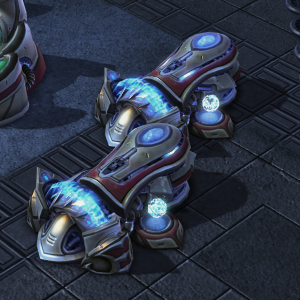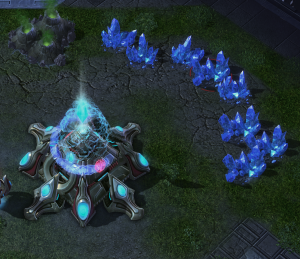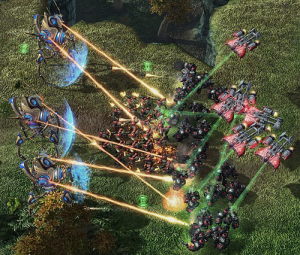Starcraft 2 Economics

Strategy and economics go hand-in-hand in Starcraft 2. For those of you who are unfamiliar with economics; economics is not just related to money but also to production and consumption. These things are the basis of some of the most important concepts in SC2. These concepts are: spending all of your resources, the idea of constant production, the relationship between tech and army size and the idea of expanding. In this article I will introduce you to these concepts and explain why they are so important.
Spend!

Dual forges can help you spend that extra money.
There is this feeling that carries over from other games or perhaps even from life where we think that having a lot of resources is a good thing. One of the first things to do in Starcraft 2 is to destroy this notion. Your resources are not points! If you lose a match with 2000 minerals in the bank you should immediately know why. To further clarify, 400 Minerals is too much, 500 and you should start to panic!
Having trouble spending your minerals? Make sure you are:
- Building workers.
- Building army.
- Expanding.
- Researching upgrades.
- Putting pressure on your opponent.
- Building more unit producing structures.
- Building static defences.
- Not getting supply blocked (Build pylons/depots/overlords early and often).
If you get to the bottom of the list and still have resources, great! Now repeat those same steps.
The Idea of Constant Production
This is the first and probably the most important economic concept in Starcraft 2, and probably in other real time strategy games. You should be constantly producing both workers (SCV’s, Probes & Drones) and army units non-stop, back-to-back for the entire game. Constant production will help you both spend all of your money and get more (to spend).
Workers
From the very beginning of the match you should be constantly building workers. The optimum (saturation) amount of workers for one mineral patch is 3 per mineral patch and 3 per gas geyser. Thats about 36 workers in total. But don’t stop there, keep producing those workers. Once you have an expansion every additional worker you have produced (and probably a few more for greater efficiency) can be transferred over to begin mining immediately, giving your income a boost right away. Eventually there is a point where you will want to cut worker production, generally you will learn this point when you will get killed because your army is too small. I have found this point to be anything greater than 90 workers, on three active bases. Any more than that and I have found that my economy is much greater than what I can spend and that my army is too small.
Army
Unlike worker production you will almost never want to cut production of your army. If a unit producing structure is not currently doing anything then it is a waste of resources. You should train yourself to cringe whenever you notice that you are not building units from a building, I know I do whenever I watch my replays. In my article on ‘Getting Used to the Keyboard‘ I wrote about the idea of producing units whilst in battle and the advantage it can give you. If you can manage to do this without any pause you will find that you will be able to reinforce your army enough to overcome most opponents regardless of how well they control their army. Zerg players are known for doing something called a ‘300 food push’ where they are able to rebuild their army almost as quickly as it is destroyed.
Focusing on constant production alone can improve your play more than anything else can. It should always be in your mind and you should even play matches where your main focus is simply to produce non-stop. If you are having trouble maintaining constant production then I highly recommend you check out Day[9]’s Daily #132 where he talks about ‘The Mental Checklist’. Remember not to be too hard on yourself, even the pros miss a worker sometimes.
Note: Don’t queue up units, those queued up units cost resources that could be spent on other things. If you have the money to queue then build another production building and build from it.
The Idea of Expanding

It takes a while for an expansion to become valuable, at the moment this one is still a 400 mineral loss.
Generally speaking, expanding is a good decision as it effectively doubles (for each expansion) your unit production ability. If you were able to build constantly out of four unit producing structures on one base you will be able to do the same with eight on two bases. Each expansion also adds two more Vespene geysers that can be used to build a higher tech army. However, there is one additional thing to note.
An Expansion is a Long-Term Investment
An expansion costs a decent chunk of minerals, and those minerals could have been used to add more units to your army. So if you spend those minerals on an expansion you must be prepared to wait for the return on your investment. It is a good idea to expand when you are being aggressive, but if you were planning on trying to kill your opponent with your attack those minerals would have been better spent bolstering your force. So have a plan before you begin. Do you want to put all of resources into one powerful attack to crush your opponent? Or do you want to expand and play a longer game with the intention of out producing and strangling your opponent? It is very important to make this decision and not to sit somewhere in between.
I will cover the topic of expanding in a future article as knowing when, where and how to expand is difficult to learn and requires a detailed discussion.
Tech vs. Army Size

A small high-tech Protoss army faces an overwhelming low-tech Terran army.
How you spend your resources is almost as important as how quickly you spend them. It’s important to know that there is a direct relationship between level of tech and initial army size. In the beginning of each match you have only limited resources, specifically, 2 Vespene geysers available to you. This creates a a situation where you must make a decision to either have a larger army or a technologically superior one. Generally, a larger army is better than a smaller one, but higher tech gives you more options. With a higher tech army your objective will be to take advantage of your opponents weaknesses (such as exploiting your opponents lack of detection to harass with cloaked units) in order to buy yourself time to create a larger, more effective army.
How This Changes in the Late Game
As you move towards max supply you should begin to favour more expensive, higher tech units instead of the basic units. This will ensure that your maxed army is efficient, that is, more durable and useful. Day[9] discusses this concept in great detail in his Daily #249. It is important to realise the difference between the early stages of the game where you make the decision between a large army or a high tech one, and the late stages of the game where you almost certainly need to be favouring higher tech units.
My experience is that at the lower levels army size wins out over a teching opponent more often than not. Prior to writing this article I played approximately ten matches in which I built mainly Stalkers and Zealots in mass quantities whilst expanding and investing in upgrades. I won 80% of those matches, which is unusual because my win/loss ratio is usually around 55%. I am going to continue to test this method and I may end up writing an article on my findings.
Spending all of my resources and constant production are two things which I am struggling with. I always seem to end up with over 2000 minerals! But practicing Day[9]’s ‘Mental Checklist’ is seeing me steadily improve.
Which of these topics do you have the most trouble with? What have you done to improve?
Thanks to FaDeMeatex and the rest of SEA BattleNet for their input into this and other articles. Feedback is always appreciated.
